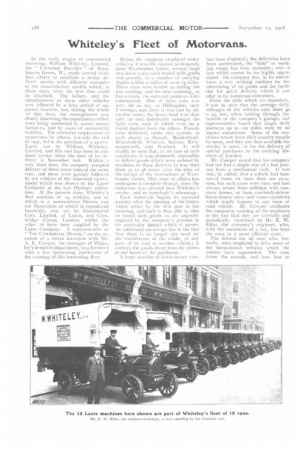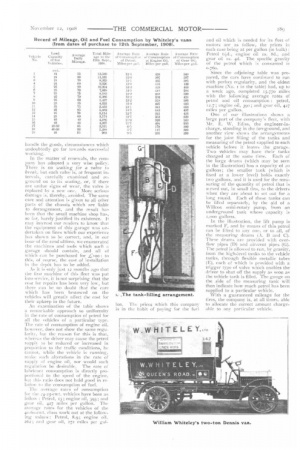Whiteley' s Fleet of Motorvans.
Page 2

Page 3

If you've noticed an error in this article please click here to report it so we can fix it.
In lie early stages of commercial motoring, William Whiteiev, Limited, the " Universal Provider ' of Westbourne Grove, W., made several fruitless efforts to establish a motor delivery service with different examples 01 the unsatisfactory models which, in those days, were the best that could be obtained. The failure, and the abandonment of these older vehicles was followed by a long period of apparent inaction, but, during the whole of that time, the management was closely observing the experiments which were being conducted 1JV motor manufacturers, and by users or commercial vehicles. The extensive employment of motorvans by others, towards the end of 19°7, led to the purchase of a 24-cwt. Lacre van by William Whiteley, Limited, and this van has been in constant service since the date of its de
livery in November last. Within a very short lime, the company accepted delivery of three more vans of the same type, and these were quickly followed by ten vehicles of the improved 25-eWt. model which was shown by the Lacre Company at the last Olympia exhibi • tion. At the present time, Whiteley's fleet consists of 19 vehicles, one of which is a worm-driyen Dennis van (an illustration of which is reproduced herewith), two :ire by Commercial Cars, Limited, of Luton, and Cambridge Circus, London, whilst the other 16 have been supplied by the Lacre Company. A representative of " THE CommERcLu. MoToR," on the occasion of a recent interview with Mr. A. E. Cowper, the manager of Whiteley's despatch department, was favoured with a few interesting particulars of the running of this increasing fleet.
Before the company employed motor vehicles, It Was he custom to despatch, from Westbourne Grove, several large two-horse vans, each loaded with goods and parcels, to a number of outlying depots within a radius of 12 or 15 miles. These vans were loaded up during the late evening, and the next morning, at five o'clock, the outward journeys were conunenced. One or these verris was sent, let us say, to Hillingdon, near Uxbridge, and there /i was met by six smaller vans; the heavy load was then split up and distributed amongst the light vans, each of which went on a round distinct from the others. Parcels were delivered, under this system, to such places 4is Slough, Maidenhead, Beaconsfield, Windsor, Shrines, Rickmansworth, and Watford. It will readily be seen that, in the face of such contiiions, it was absolutely impossible to deliver go Each moturvan begins its outward journey after the opening of the letters which arrive by the first post in the morning, and each is thus able to take on board such goods as are urgently required by the company's patrons in the particular district which it serves. An additional advantage lies in the fact that there is no longer ;my need for thetransference of the whole, or any part, of its load to another vehicle; it conveys the goods direct from the stores to the house of the purchaser. A large number of horseedrakvn vans has been displaced; the deliveries have been accelerated the "field" or working range has been extended; and—a fact which cannot be too highly appreciated—the company has, in its motorvans, a very striking medium for the advertising of its goods and the facilities for quick delivery which it can offer to its numerous customers. From the table which we reproduce, it can be seen that the average daily mileages of the vehicles vary from 40 to 95, but, when looking through the records at the company's garage, our representative found that single daily journeys up to 120 miles were by no means uncommon. Some of the machines return from their country rounds by noon, and they are then available for service in town, or for the delivery of special purchases in the outlying districts of London. Mr. Cowper stated that his company had not had a single case of a lost journey from a mechanical fault. It was true, he ridded, that a vehicle had been towed home on more than 011e occasion, but such cases were rare, and had always arisen from collision with runaway horses, or from carelessly-driven horse-drawn carts and vans—accidents which might happen to any form of road vehicle. Mr. Cowper attributes the consistent running of the machines to the fact that they are carefully and periodically examined by Mr. E. W. Ediss----the company's engineer, who, with the assistance of a boy, has kept the vans in a most efficient state. The drivers are all men %dm, formerly, were employed to drive sonic of the horse-drawn vehicles which the motors have superseded. The men know the rounds, and how best to handle the goods, circumstances which undoubtedly go far towards successful working. In the matter of renewals, the company has adopted a very wise policy. There is no waiting for a valve to break, but each valve is, at frequent intervals, carefully examined and reground on to its seating, or, if there are undue signs of wear, the valve is replaced by a new one. More serious damage is, thereby, avoidtxl. The same care and attention is given to all other parts of the chassis which are liable to derangetnent, and the result has been that the small machine shop has, so far, barely justified its existence. It may interest our readers to know that the equipment of this garage was undertaken on lines which our experience has shown to be correct, and, in our issue of the 22nd ultimo, we enumerated the machines and tools which such a garage should contain, and all of which can he purchased for TOO : to this, of course, the cost of installation in the depot has to be added. As it is only just 12 months ago that the first machine of this fleet was put into service, it is not surprising that the cost for repairs has been very low, but there can be no doubt that the care which has been bestowed on the vehicles will greatly affect the cost for their upkeep in the future. An examination of the table shows a remarkable approach to uniformity in the rate of consumption of petrol for all 1Iw vehicles of a particular type. The rate of consumption of engine oil, however, does not show the same regularity, but the reason for this is that, whereas the driver may cause the petrol supply to be reduced or increased in P roportion to the traffic mmditions, lit cannot, while the vehicle is running, make such alterations in the rate of supply of engine oil, nor would such regulation be desirable. The rate of lubricant consumption is directly proportional to the speed of the engine, but this ratio does not hold good in relation to the consumption of fuel. The average rates of consumption for the 24-25-cwt. vehicles have been as follow : Petrol, 13; engine oil, 393; and gear oil, 427 miles per gallon. The average rates for the vehicles of the 40-04o-cwt. class work out at the following values : Petrol, 809; engine oil. 262; and gear oil, 272 miles per gal and oil which is needed for its fleet of motors are as follow, the prices in each case being at per gallon (in bulk): Petrol OA., engine oil is. 8d., and gear oil is. 4d. The specific gravity of the petrol which is consumed is 0.760. Since the adjoining table was prepared, the cars have continued to run with perfect regularity, and the oldest machine (No. i in the table) had, up to a week ago, oompleted 15,77o miles with the following average rates of petrol and oil consumption : petrol, 12.7; engine oil, 391) ; and gear oil, 427 miles per gallon. One of our illustrations shows a large part of the company's fleet, with Mr. E. W. Ediss, the engineer-incharge, standing in the foreground, and another view shows the arrangements for the joint filling of the tanks and measuring of the petrol supplied to each vehicle before it leaves the garage. Two vehicles may have their tanks charged at the same time. Each of the large drums (which may be seen in the illustration) has a capacity of 20 gallons; the smaller tank (which is lixed at a lower level) holds exactly two gallons, and it is used for the measuring of the quantity of petrol that is served out, in small tins, to the drivers when they are about to set out for a long round. Each of these tanks can be tilled separately, by the aid of a Willcox semi-rotary puny, from an underground tank whose capacity is 1,1)1)0 gallons. In the illustration, the lift pump is marked F, and by means of this petrol can be lifted to any one, or to all, of the measuring drums (A, B and C). These drums are provided with overflow pipes (D) and air-vent pipes (G). The petrol is allowed to run, by gravity, from the high-level tanks to the vehicle tanks, through flexible metallic tubes (E), each of which is provided with a trigger type of valve which enables the driver to shut off the supply as soon as the vehicle tank is filled. The gauge on the side of the measuring tank will then indicate how much petrol has been supplied to a particular vehicle. With a guaranteed mileage for the tires, the company is, at all times, able to allocate the correct amount chargeable to any particular vehicle.






















